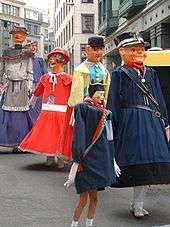Meyboom
The Meyboom plantation (or Meiboom in Dutch, "May tree" – a bastardisation of the Dutch tree of joy) is the oldest tradition in Brussels (Belgium), attested since 1308. It is held every year on 9 August, the eve of St Lawrence's Day, and consists mainly in planting a beech at the intersection of Rue des Sables/Zandstraat and Rue du Marais/Broekstraat.
| Meyboom | |
|---|---|
The planting of the Meyboom in Brussels | |
| Status | Active |
| Frequency | Annual |
| Location(s) | City of Brussels, Brussels-Capital Region |
| Country | Belgium |
| Inaugurated | c. 1308 |
| Most recent | August 9, 2019 |
| Next event | August 9, 2020 |
| Website | Official website |
The celebration commemorates a victory of Brussels over the city of Leuven in 1213. To respect the tradition, the tree of joy must imperatively be planted before 5 p.m. It is accompanied by processions and various folk activities during the day.[1]
Since 2008, the Meyboom has been recognised as an expression of intangible cultural heritage by UNESCO, as part of the binational listing of 'Processional giants and dragons in Belgium and France'.[2]
Celebrations
The tree is designated by the city's Plantation Department and "chosen" by the Companions of St Lawrence in the Sonian Forest, in the outskirts of Brussels. According to tradition, it must weigh at least 600 kg (1,300 lb), measure 12–13 m (39–43 ft) in height and be leafy. It is cut and then transported by Bûûmdroegers ("tree bearers"), through the municipalities of Schaerbeek, Saint-Josse-ten-Noode and the City of Brussels. At 1 p.m., a tribute is paid to the deceased Companions.
The procession then forms at the corner of Rue du Marais/Broekstraat and Rue des Comédiens/Komediantenstraat (near the local brotherhood of the Companions, at 37, rue des Sables/Zandstraat), and sets off along a fixed route: Rue du Fossé aux Loups/Wolvengracht, Place de la Monnaie/Muntplein, Rue des Fripiers/Kleerkopersstraat, Rue de Tabora/Taborastraat, Rue du Midi/Zuidstraat, Rue du Lombard/Lombardstraat, Rue de l'Étuve/Stoofstraat, Rue de l'Amigo/Vruntstraat and the Grand Place.
At 2.45 p.m., the procession returns from the Grand Place via Rue Chair et Pain/Vlees-en-Broodstraat, Rue du Marché aux Herbes/Grasmarkt, Rue de la Fourche/Greepstraat, Rue de l’Écuyer/Schildknaapsstraat, Rue Montagne aux Herbes Potagères/Warmoesberg, and finally returns to the corner of Rue des Comédiens/Komediantenstraat and Rue du Marais/Broekstraat around 4.30 p.m. Along the way, small branches of the tree are distributed, supposed to bring good fortune for the year to come. The culmination is the plantation itself, which must take place before 5 p.m. The tree is in fact not really planted but stuck in the ground and removed the next day.

A halt in Schaerbeek for the procession of the Meyboom in 2008 
Giants of the Meyboom of Brussels 
Giants of the Meyboom of Brussels
References
- "Meyboom — Région bruxelloise - Brussels Gewest". be.brussels. Retrieved 2018-09-22.
- "Processional giants and dragons in Belgium and France - intangible heritage - Culture Sector - UNESCO". ich.unesco.org. Retrieved 2018-09-22.